Home » Hunting Dogs » Dunker: The Norwegian National Harehound
Dunker: The Norwegian National Harehound
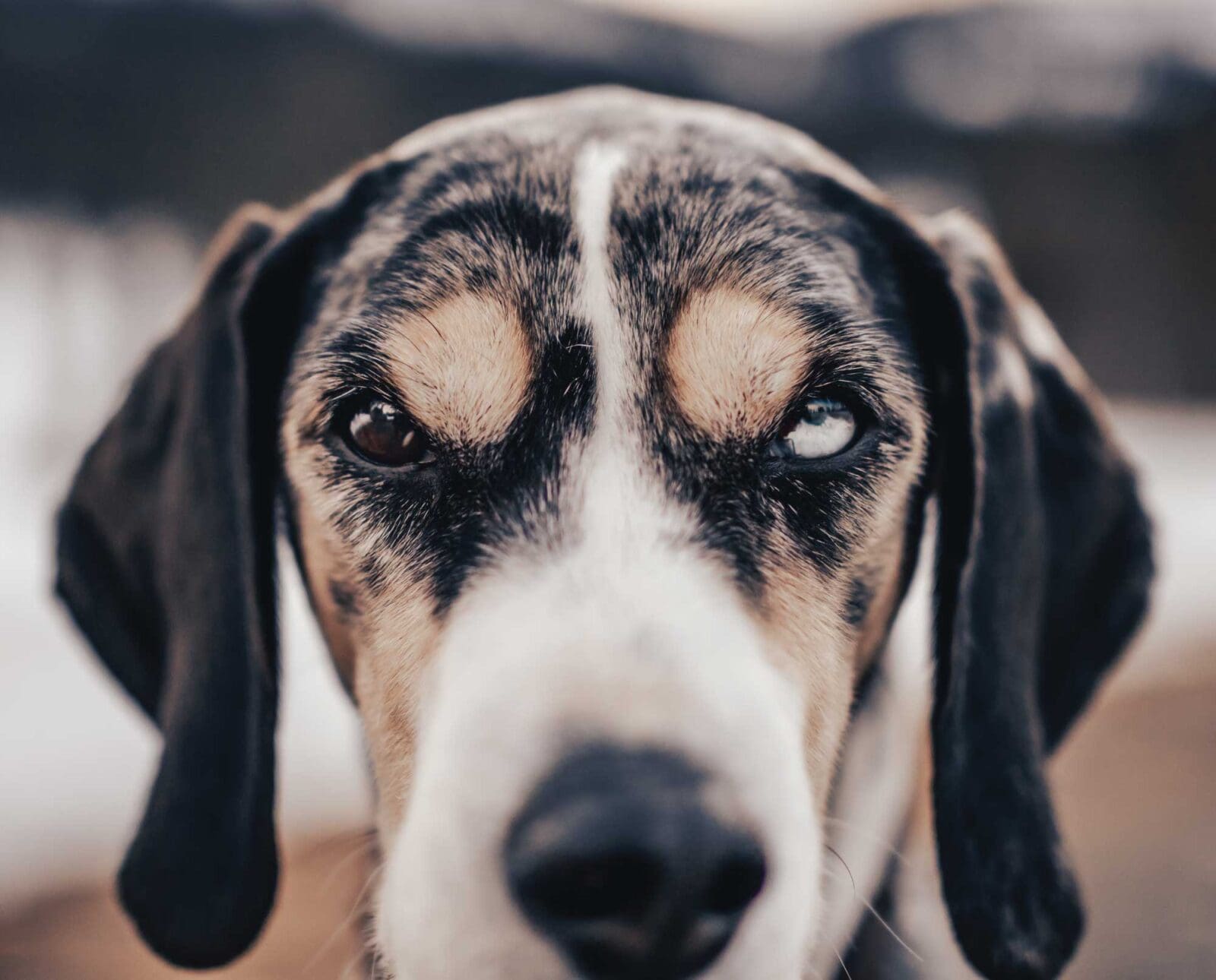
Håvard Mørch is a carpenter who hunts with a single…
In this rugged country made of sea, fjords, high mountains, and dark forests, there is a well-kept secret of the Norwegian Hound.
The Norwegian Hound, also known as the Dunker, is one of the seven Norwegian native dog breed varieties—a scent hound with outstanding hunting qualities. The mottled color and glassy eyes make it quite distinguished and different from other hare hounds.
Listen to more articles on Apple | Google | Spotify | Audible
History and Overview of the Dunker
The breed’s history traces back to 1820, when General Jakob Krefting procured a dog named Hvide Musikk from a group of homeless travelers. Some believed the dog had Scottish or English ancestry, while others believed that it was descended from Swiss or German dogs, owing to the similarly spotted coat of the German Holstein Hound.
Captain Wilhelm Conrad Dunker, after whom the breed would eventually be named, bred a bitch with a marbled coat to Hvide Musikk. When the pups were born, five of them had a blue merle coat and most had the blue “glass” eyes for which the breed is now known.
During the latter half of the 1800s, others followed in Captain Dunker’s footsteps and, by line breeding among the descendants of his dogs, established the breed which was recognized by the Norwegian Harehundklub in 1902.
Today, the Dunker is highly regarded as a hunting dog in Norway, but is more or less unknown outside of Scandinavia. They are very cooperative in the woods and give strong voice while pursuing game. They have a good reputation for being “honest,” which is to say that they will track and bay only hares and not other game animals such as deer. It also means that their vocalization during the pursuit alerts the hunter to the location of the quarry and the dog’s relative position.
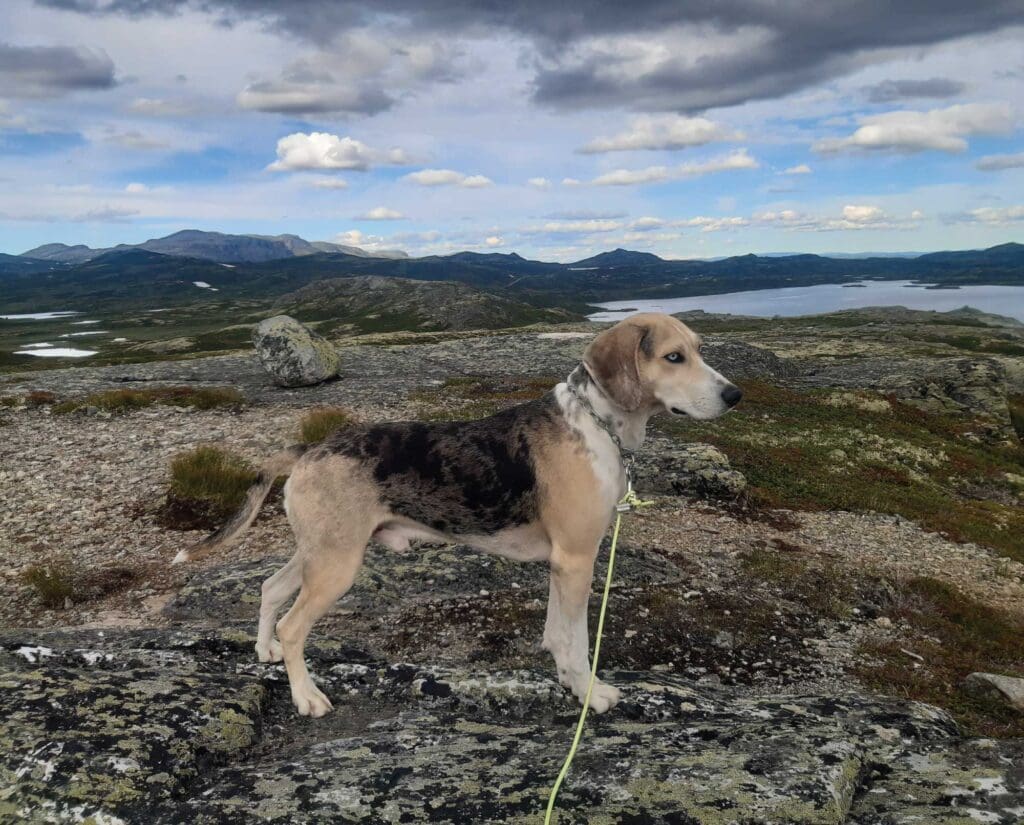
To top it all off, the breed has particularly strong paws, able to withstand the wear and tear of ice and slush so that a Dunker can continue hunting when other breeds cannot.
Johan Skei, a late member of our breed club, described them as follows. “They have paws of steel and an enormous amount of hunting desire, searching for game in a wide area and working independently.”
The modern Dunker comes in two color variations: black-and-tan and blue merle. They are considered a national treasure of Norway that hunters have lovingly bred for over 200 years. They have been used by generations of hunters to pursue mainly Eurasian mountain hare (Lepus timidus), but can also be used to hunt fox and lynx. They are well-built dogs, capable of chasing and baying for hours on bare ground or on the snow- and ice-covered ground in the winter.
Dunker Harehounds in the Field
In Scandinavia, we use harehounds differently than hunters in other countries. Instead of running them in packs—which is illegal here—we run our dogs solo.
Like hound handlers everywhere, we know that the weather has a huge influence on the scenting conditions. The best weather is when the ground is warm and slightly moist and the air is cold.
The hunter and his hound head out early in the morning to find a suitable place to chase hare. Once there, the unleashed dog searches far and wide to find what we call “harefoot,” the tiny particles of hare scent left on the ground in the area where the hare spent the night grazing. Once the dog finds that area, it follows the foot scent that the hare left behind as it moved to a resting or sleeping spot.
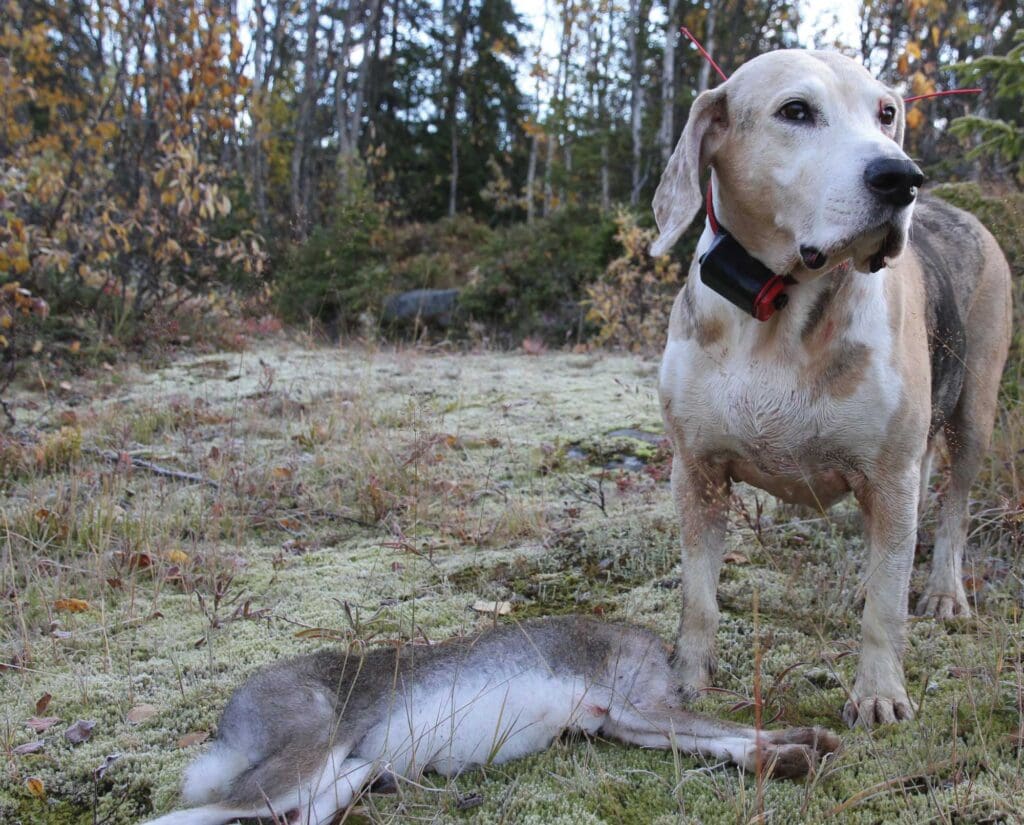
Since the hare had spent most of the night in the area, eating and moving around, it leaves an incredible jumble of scent behind. The Dunker dogs are bred to unravel the mystery and figure out which way the hare went. Once they do, they follow the foot scent to find where the hare is resting or sleeping. When they eventually come upon the hare, you will usually hear a long bark that sounds almost like the dog is screaming. This will last for a few seconds until the dog switches to a more pronounced barking voice, which we hunters call “the music of the forest.”
Now the hare is in motion with the dog in pursuit. The Dunker should be honest in the chase and let the hunter know how close or far away it is from the hare. The closer the dog is to the hare, the more intense the barking; the further behind the dog is, the longer the pause between barks. This technique allows the hunters to “read the hunt” and know when to be prepared for a shot.
Mountain hares are wily and, during the chase, will do their best to lose the dog by making many twists and turns. For example, a hare may hop down to a gravel road for 100 yards, turn 180 degrees, hold his breath, and follow its old tracks back 50 yards. Then it will make a large jump at 90 degrees to the track to put more distance between it and the dog. This can lead to what we call a “loss.” The dog will follow the original 100 yards of scent along the gravel road, but then loses the “thread of the scent” and has to figure out where the hare went. Ideally, the dog should work in circles around the point where he lost scent to figure out exactly where the hare slipped away. If the dog finds the spot where the hare jumped, he will resume the chase; if he doesn’t, it will result in what we call a “dead loss.”
A dead loss can also occur for other reasons, such as when the hare slips between large rocks or jumps up onto a high boulder to make the thread of scent become more difficult to follow.
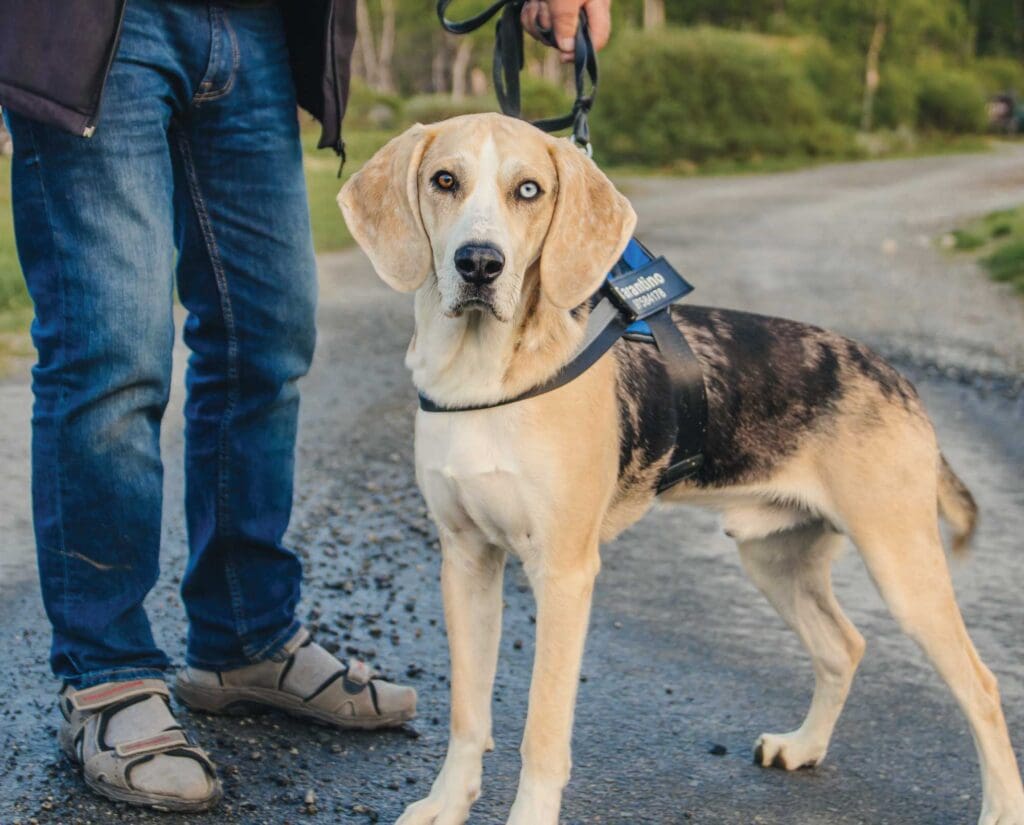
As for the hunter, finding a good place to post is not easy. The best spots are usually on paths that are criss-crossed with hare trails because these are the routes that hare use most often when pursued. Spots like that give the hunter several shooting lanes to choose from when the hare arrives. Another good spot to stand and wait is at the place where the dog first found the hare, since hares tend to circle back to this spot at some point during the chase. But the dogs cover a huge area in their search—they sometimes find hares up to 400 yards away and can chase them another 1000 yards further if luck is not on your side.
Hare hunting is an old sport and has many traditions that date back to Germanic hunting cultures of the 1800s. But beyond the tradition, I find that the real pleasure of hare hunting comes from the social aspect.
Two or three of my friends and I will often share a campfire and enjoy some food along with the good company. As we do, the dog will come by from time to time to check in on us before going back out in search of hare, and that is the way we like it. There is no hurry to shoot a hare when hunting and it is often said that “the worst shooter gets the best dog” because by missing a lot, the hunter gives the dog more opportunities to pursue game and learn how to figure out the hare’s tricks.
Unfortunately, there are very few hare hunters left that use long-legged harehounds like the Dunker. Like many places, the population of hunters in Scandinavia is aging and there is now a move towards using dogs in field trial competitions more than in actual hunting. But there are still people like me who are passionate about hare hunting. It is a beautiful form of hunting with a magnificent dog, which you can enjoy with the whole family, or friends young and old.
A Memorable Hunt
All hunters have a favorite story of a memorable hunt. Mine took place in Blefjeell, a mountainous area about two hours east of Oslo.
One day my friends Fredrik, Håkon, and I took my first Dunker, a young and inexperienced blue merle named Ivo, out for his first hare hunt. As we drove east in the early morning light, we could see our destination in the distance and I got butterflies in my stomach.
The foot of the mountain is covered by pine and spruce. Higher up, birch begins to cover the landscape of glistening mountains and marshes. The area is well-known for skiing and hiking and, as a result, there are a lot of cabins there. But there are also a lot of hares, sometimes even too many. We parked my old, gray truck as high as we could get in the rough terrain. As we exited the vehicle and caught our first breaths of fresh mountain air, we could see hare droppings everywhere.
I took Ivo up a long path and picked a spot to set up our portable chairs. As my friends and I sat down and I unleashed Ivo, we were filled with excitement. Would this be the day we get to shoot his first hare?
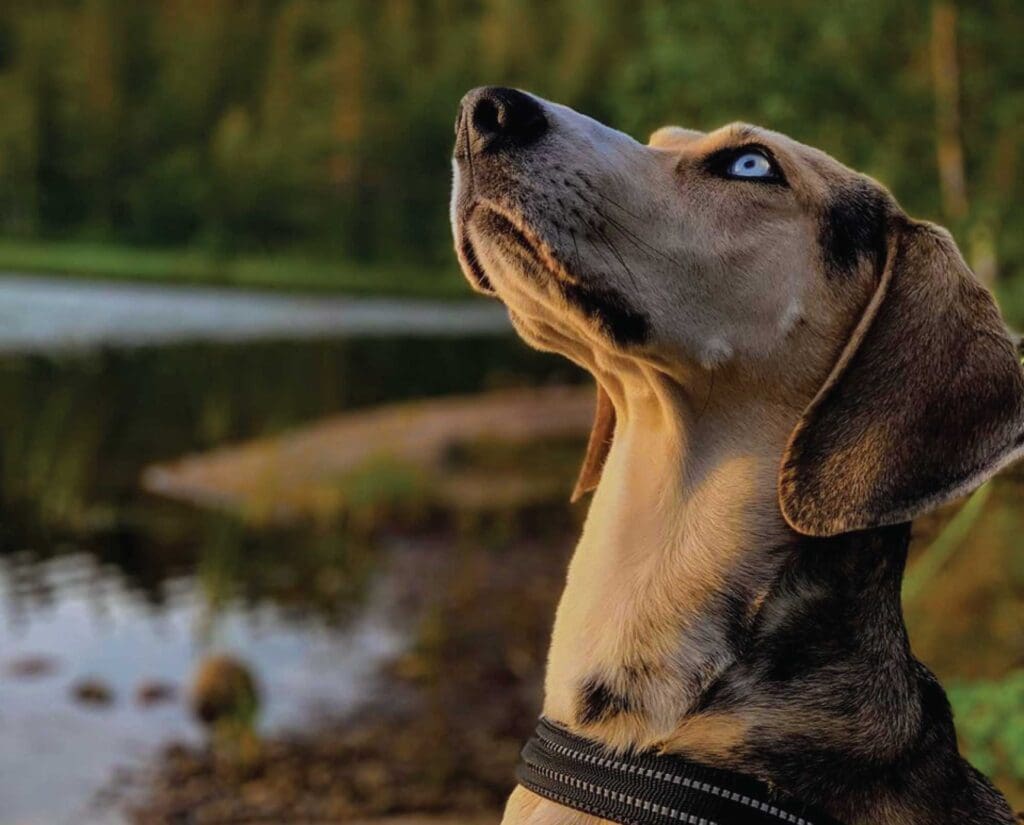
The morning sun peeked just above the mountain top and steam began to rise from the ground into the cold mountain air. My dog had run down between a valley between two birch-covered hills, about 100 yards away from us. He hadn’t given us any signs yet, but we watched him closely from our vantage point while enjoying a cup of coffee as the smoke from our campfire hung low in the air like fog.
Soon Ivo was out of sight, but we could follow his movements with the GPS collar. Approximately 40 minutes later, we heard a howling bay out in front of us, at about 400 yards. We saw neither hound nor hare. Our heart rates all jumped as we each found a place to post. I found a good spot at the top of the path, Fredrik took the far end of a field, and Håkon stood near where we had parked the truck, at the bottom of an overgrown tractor trail. Over the next 20 minutes, the dog and hare passed between us several times, giving us three or four chances to see the hare itself. The dog was so loud and the hare chose to run between cabins, so the baying woke up everyone inside. But my focus was on the incredible mountain-opera going on around us and I knew I had to get this hare for my dog who had been doing such a fantastic job.
Then, suddenly, all went quiet. Had the hare found shelter under a porch? I watched and listened. Håkon used his radio to let me know that the hare was still running but had turned off the road and Ivo was trying to figure out which way it went. Almost immediately, he found the trail again and was back in pursuit. I thought I heard in his baying voice that the hare’s tricks had annoyed him, but maybe it was just my human emotions getting the better of me.
There’s the hare! I saw it snaking slowly through the tall grass near the old dairy farm on my right. I could only see the grass moving and a pair of easily recognizable ears. The hare stopped and listened for the hound a couple of times, then jumped down onto the old tractor road. It crossed the trail about 60 yards away from me and then disappeared behind some trees.
A couple of minutes later, it hopped back onto the road and moved in my direction. The road was so steep and rocky that I couldn’t follow it with my eyes, so I just hoped it would come closer.
I calmly raised my old Spanish side-by-side shotgun and took the safety off. The gun was loaded with number 3s and the hammers were cocked. Peeking down the road, I could see the hare hopping towards me. I fired. My cheer of happiness could be heard across the entire valley—my first hound and his first hare were now a reality.
I stood near the dead hare and waited for Ivo who was still working the trail, unaware that I had shot the quarry. He trotted right past me, then threw his head back in surprise. He found the hare, sniffed it intensely, nibbled on the fur, and then picked it up and brought it to me, his tail twirling like a propeller.
The moment brought a small tear to my eye. I’d spent several hundred hours in the woods, day and night, patiently training that dog. I was so proud of the work he did.
Later on, my friends and I gathered around the fire with Ivo safely leashed. We opened the hare and emptied its stomach. According to our old hunting tradition, the hound should receive the entrails as a reward. Not all dogs will take the entrails right away, but Ivo did.
After the hare was cleaned, we put fresh juniper in the stomach to keep the meat fresh and fragrant and to make the hare look nicer while it hung on the cabin wall to tenderize.
With a hare in the bag, we lifted our glasses of traditional jäger schnaps and toasted the day: “Skål!”
Håvard Mørch is a carpenter who hunts with a single Norwegian hound (Dunker). He primarily pursues Eurasian fox and Eurasian mountain hare in the deep forests and mountains of eastern Norway, but occasionally he likes to switch it up by hunting capercallie and black grouse,




Good story love bird dogs but have always had hounds and nothing like listening to a good race
Noticed you didn’t mention them “in the home”. Or the current state of the breed, the much needed mixing to keep them going. They are a wonderful dog, that is quit the acquired taste. Thank you for your article. Should definitely talk about them as “pets” so that the right people will want for them, if you get my understanding, “the breed is not a pet”. It’s not made that way.
Hey.
They are remarkable as pets, indoors aswell. I had my dunker inside and used a open crate at night.
Not a sound. He loved everyone.. they got a good “on/off” button from hunting and everyday life. Super calm and chill..
When someone was at the door, he didnt bark or nothing. Just tail wiggling. Good mentality, stable hounds. Great with kids.
The mixing of the breed happens every 5 to 10 years to use some finnish harehound, hammiltonstøver or hygenhund to get less homogeneous breeding. Solveig they will in colour the first 1-2 litters after first cross breeding. But the base from the Scandinavian harehounds they are all based on a mix of local variations.. now they have to go threw generations on the pedigree on both sides for huntingrecord, mentallrecord, sicknessrecord and appearance records before choosing individuals before breeding. Mix or not.
They choose what counts as a dunker or a hygenhound for example based on the colouring. Cause hygen and dunker was once one breed.. hope this gave you what you asked for 🙂
Best regards from Norway